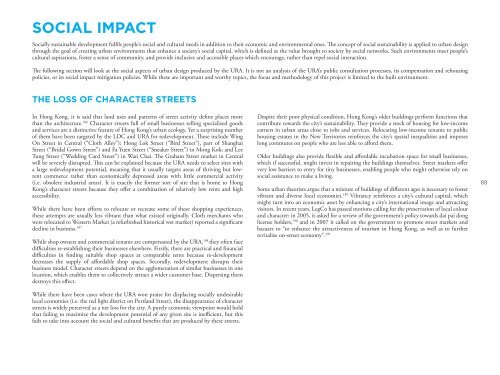Treating the Symptoms - A Critical Review of ... - Civic Exchange
Treating the Symptoms - A Critical Review of ... - Civic Exchange
Treating the Symptoms - A Critical Review of ... - Civic Exchange
- No tags were found...
You also want an ePaper? Increase the reach of your titles
YUMPU automatically turns print PDFs into web optimized ePapers that Google loves.
Social ImpactSocially sustainable development fulfils people’s social and cultural needs in addition to <strong>the</strong>ir economic and environmental ones. The concept <strong>of</strong> social sustainability is applied to urban designthrough <strong>the</strong> goal <strong>of</strong> creating urban environments that enhance a society’s social capital, which is defined as <strong>the</strong> value brought to society by social networks. Such environments meet people’scultural aspirations, foster a sense <strong>of</strong> community, and provide inclusive and accessible places which encourage, ra<strong>the</strong>r than repel social interaction.The following section will look at <strong>the</strong> social aspects <strong>of</strong> urban design produced by <strong>the</strong> URA. It is not an analysis <strong>of</strong> <strong>the</strong> URA’s public consultation processes, its compensation and rehousingpolicies, or its social impact mitigation policies. While <strong>the</strong>se are important and worthy topics, <strong>the</strong> focus and methodology <strong>of</strong> this project is limited to <strong>the</strong> built environment.The Loss <strong>of</strong> Character StreetsIn Hong Kong, it is said that land uses and patterns <strong>of</strong> street activity define places morethan <strong>the</strong> architecture. 186 Character streets full <strong>of</strong> small businesses selling specialized goodsand services are a distinctive feature <strong>of</strong> Hong Kong’s urban ecology. Yet a surprising number<strong>of</strong> <strong>the</strong>m have been targeted by <strong>the</strong> LDC and URA for redevelopment. These include WingOn Street in Central (“Cloth Alley”); Hong Lok Street (“Bird Street”), part <strong>of</strong> ShanghaiStreet (“Bridal Gown Street”) and Fa Yuen Street (“Sneaker Street”) in Mong Kok; and LeeTung Street (“Wedding Card Street”) in Wan Chai. The Graham Street market in Centralwill be severely disrupted. This can be explained because <strong>the</strong> URA needs to select sites witha large redevelopment potential, meaning that it usually targets areas <strong>of</strong> thriving but lowrentcommerce ra<strong>the</strong>r than economically depressed areas with little commercial activity(i.e. obsolete industrial areas). It is exactly <strong>the</strong> former sort <strong>of</strong> site that is home to HongKong’s character streets because <strong>the</strong>y <strong>of</strong>fer a combination <strong>of</strong> relatively low rents and highaccessibility.While <strong>the</strong>re have been efforts to relocate or recreate some <strong>of</strong> <strong>the</strong>se shopping experiences,<strong>the</strong>se attempts are usually less vibrant than what existed originally. Cloth merchants whowere relocated to Western Market (a refurbished historical wet market) reported a significantdecline in business. 187While shop owners and commercial tenants are compensated by <strong>the</strong> URA, 188 <strong>the</strong>y <strong>of</strong>ten facedifficulties re-establishing <strong>the</strong>ir businesses elsewhere. Firstly, <strong>the</strong>re are practical and financialdifficulties in finding suitable shop spaces at comparable rents because re-developmentdecreases <strong>the</strong> supply <strong>of</strong> affordable shop spaces. Secondly, redevelopment disrupts <strong>the</strong>irbusiness model. Character streets depend on <strong>the</strong> agglomeration <strong>of</strong> similar businesses in onelocation, which enables <strong>the</strong>m to collectively attract a wider customer base. Dispersing <strong>the</strong>mdestroys this effect.While <strong>the</strong>re have been cases where <strong>the</strong> URA won praise for displacing socially undesirablelocal economies (i.e. <strong>the</strong> red light district on Portland Street), <strong>the</strong> disappearance <strong>of</strong> characterstreets is widely perceived as a net loss for <strong>the</strong> city. A purely economic viewpoint would holdthat failing to maximize <strong>the</strong> development potential <strong>of</strong> any given site is inefficient, but thisfails to take into account <strong>the</strong> social and cultural benefits that are produced by <strong>the</strong>se streets.Despite <strong>the</strong>ir poor physical condition, Hong Kong’s older buildings perform functions thatcontribute towards <strong>the</strong> city’s sustainability. They provide a stock <strong>of</strong> housing for low-incomeearners in urban areas close to jobs and services. Relocating low-income tenants to publichousing estates in <strong>the</strong> New Territories reinforces <strong>the</strong> city’s spatial inequalities and imposeslong commutes on people who are less able to afford <strong>the</strong>m.Older buildings also provide flexible and affordable incubation space for small businesses,which if successful, might invest in repairing <strong>the</strong> buildings <strong>the</strong>mselves. Street markets <strong>of</strong>fervery low barriers to entry for tiny businesses, enabling people who might o<strong>the</strong>rwise rely onsocial assistance to make a living.Some urban <strong>the</strong>orists argue that a mixture <strong>of</strong> buildings <strong>of</strong> different ages is necessary to fostervibrant and diverse local economies. 189 Vibrancy reinforces a city’s cultural capital, whichmight turn into an economic asset by enhancing a city’s international image and attractingvisitors. In recent years, LegCo has passed motions calling for <strong>the</strong> preservation <strong>of</strong> local colourand character: in 2005, it asked for a review <strong>of</strong> <strong>the</strong> government’s policy towards dai pai donglicense holders, 190 and in 2007 it called on <strong>the</strong> government to promote street markets andbazaars to “to enhance <strong>the</strong> attractiveness <strong>of</strong> tourism in Hong Kong, as well as to fur<strong>the</strong>rrevitalize on-street economy”. 19193
















